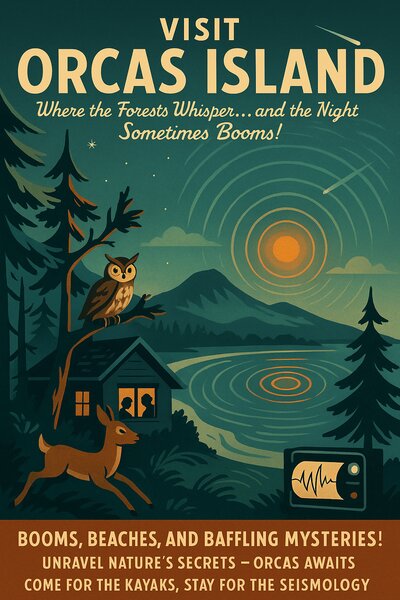A Sleepy Island Shaken Awake
On a chilly March predawn, Orcas Island's usual tranquility was shattered by a thunderous boom. Around 4 a.m. on March 7, 2022, residents all across this forested San Juan island jolted awake to what felt (and sounded) like an explosion. "It jolted me awake and that jolt made it hard to get back to sleep," recalls Tom Owens, a retired seismologist who had settled into Orcas's peaceful life.
Owens wasn't alone – a sonic boom rattled Orcas Islanders from their sleep at about 3:30 that morning. Some locals even reported a brief flash of light outside coinciding with the boom, as if a lightning bolt had silently struck or a meteor had streaked overhead. In the dark, homes trembled and windows shivered. Groggy 911 calls poured in, but the sheriff's deputies were as baffled as everyone else.
What on earth (or above it) had just happened? The source of this sudden, loud noise was a mystery – no downed trees, no exploded propane tanks, no obvious crater in the sand. Just the damp silence of fir groves and lapping shoreline, and a community full of questions.
Such questions weren't entirely new here. Owens himself had heard other booms in the past year. A few months prior, on Dec. 5, 2021, he'd been half-awake when "I noticed a burst of light followed by hearing the explosion," he says. That December event – a midnight flash that lit up his bedroom – was strange enough; by March, after yet another boom shook the island, Owens realized these events were becoming a pattern.
"It was probably the third explosion since I moved here, and I just thought 'this is getting strange'."
Indeed, many Orcas Islanders swapped tales of unexplained "booms in the night" that had peppered the past year. Coffee shops buzzed with chatter: Did you hear it? Did something blow up? Was it an earthquake? In a place known more for kayak tours and farmers markets than sonic shockwaves, the mystery had officially arrived.
Island Detectives with Seismographs
Unsatisfied with shrugging it off, Owens decided to put his scientist's hat back on after the March 7 blast. By daylight, he reached out to former colleagues at the Pacific Northwest Seismic Network (PNSN) at University of Washington: had their array of seismometers picked up anything around 4 a.m.?
Sure enough, they had. The seismic records showed a sharp, split-second jolt around 04:14:30 PST that morning. But curiously, it wasn't the signature of a normal earthquake at all – it was something else. Owens noticed the energy was rolling through the network at an unusual speed: much slower than typical quake tremors, more like the speed of sound in air. This hinted that whatever happened was an atmospheric event, not a tectonic one.
Intrigued, he passed his observations to PNSN's experts, essentially saying: Any thoughts on what this could be?
Enter Dr. Steve Malone – a veteran seismologist (UW Professor Emeritus and former PNSN director) who relishes a good geophysical whodunit. Malone and PNSN's team sprang into detective mode, treating the boom like a seismic cold-case. By examining the subtle vibrations arriving at stations across the San Juans, they triangulated a source.

Advanced seismic monitoring equipment helps scientists detect and analyze the mysterious explosions across the San Juan Islands.
The pulses lined up to indicate a point at the north end of Orcas Island, near Eastsound, very close to Crescent Beach Preserve. Notably, the calculated origin was at a low elevation – essentially at ground level (or not far above). In other words, this wasn't a high-atmosphere meteor blast or a far-off thunderclap; it was something that literally went boom on Orcas Island soil, or just over it.
"The seismograms are clearly from the air-waves (not seismic waves in the ground) and look to be from an explosive source near the surface."
Malone pegged the timing to 04:14:22 PST and location at roughly 48.699°N, 122.893°W, right by Crescent Beach.
Piecing Together the Boom Chronicles
As the PNSN scientists and sheriff's investigators compared notes, a timeline emerged. That March 7 boom was the latest (and loudest) of several incidents. Owens' December 2021 flash-and-boom was among them, and he mentioned at least one other mysterious bang he'd heard in the months before. The sheriff's office had records of sporadic booms going back to summer 2021.
In fact, on March 14, 2021, an explosive device was set off on neighboring San Juan Island, shattering a wooden post at a scenic overlook in False Bay. That earlier case was never solved – the vandal(s) responsible disappeared into the night – but it set an uneasy precedent. Now Orcas Island seemed to be the new epicenter of whatever was going on.

The tranquil nights on Orcas Island are periodically shattered by mysterious booms that echo across the forested landscape.
By the time of the Crescent Beach blast, no one had claimed responsibility or left obvious evidence. Early morning timing and zero claims of credit made these booms feel "less than innocent," as one observer dryly noted. In other words, this didn't look like a harmless prank or coincidence.
Local authorities, growing concerned, even recalled a chilling discovery from a few years back: in 2018, a hiker found a live improvised explosive device (IED) hidden on Orcas Island's Turtleback Mountain Preserve – complete with wires and a battery. (That bomb was safely defused, but the culprit never found.) The thought that someone might be experimenting with explosives around these islands wasn't far-fetched.
The Harmless Explanations: Nature's Whims
On one end of the spectrum, many locals hope the booms have a prosaic, non-threatening cause – an act of nature or some mundane physics we simply missed. Could it have been a sonic boom from a jet? Fighter planes from nearby Whidbey Island Naval Air Station do fly training routes in the region. A supersonic "Growler" jet can rattle windows with a sonic boom – perhaps one strayed over Orcas at the wrong time?
However, the Navy reported no known flights that night, and a military jet breaking the sound barrier at 4 a.m. over a populated island would be highly unusual (and likely against regulations).
Others recalled that on that very morning, a meteor fireball streaked across the Pacific Northwest sky around 4:30 a.m. Dozens of people from western Washington and Oregon reported seeing a brilliant green-tinged meteor burn up overhead. Could a small meteor explosion have caused the Orcas boom?
It's an intriguing coincidence – a cosmic one – but the evidence doesn't quite fit. The PNSN team noted the boom's origin was right near the ground on Orcas, not high in the atmosphere. And while a meteor can produce a sonic boom, this fireball's timing and trajectory didn't line up exactly with the 4:14 a.m. Crescent Beach event.
The Nefarious Possibilities: Humans (Mis)behaving
If not an act of God, perhaps it was an act of guy (or gal) – in other words, someone deliberately causing these booms. This theory gained traction as more facts emerged. The law enforcement stance leaned this way: multiple blasts over months, all at odd hours, with no one claiming responsibility, suggested an unauthorized explosive hobbyist or vandal at work.
Sheriff Krebs explicitly linked the Orcas booms into a "string of explosions" and asked the community's help to catch whoever might be responsible. And there was precedent: that homemade bomb detonated at False Bay the year before was a giant red flag. If a thrill-seeker was island-hopping setting off bombs, or a local troublemaker was experimenting with explosives, it could explain a lot.
By April 2022, whispers of a shadowy bomber had intensified. Neighbors began exchanging any suspicious tidbits: the distant thump heard up on Mount Constitution last fall, or that time someone's windows rattled at 2 a.m. in Deer Harbor with no storm around. PNSN's blog noted "reports in social media of the remnants of pipe bombs" being found in secluded spots on Orcas.
The pattern – wee-hour blasts, no injuries (so far), no claims – could indicate someone testing bombs or seeking a thrill while avoiding detection. It's a disturbing thought, but one the investigators could not dismiss.
The Fringe Theories: Secrets and Strangeness
Of course, no local mystery would be complete without its share of conspiracy-flavored explanations. Orcas Island, with its misty vistas and eccentric residents, is fertile ground for a bit of imaginative speculation.
One popular notion in online forums was secret underground tunneling: maybe some clandestine project was literally blasting tunnels beneath the islands. It sounds fantastical, but this theory pops up often in rural boom incidents worldwide – whispers of government black ops or tech billionaires quietly drilling underground facilities.
Then there's HAARP. Yes, the infamous High-frequency Active Auroral Research Program – a real ionospheric research array in Alaska that occupies an outsized place in conspiracy lore. Over the years, HAARP has been blamed for everything from hurricanes to earthquakes by imaginative souls. So why not mysterious booms too?
And we can't forget the extraterrestrial hypothesis – floated with a wink by some, but in earnest by others. UFO lore is rich in accounts of strange sounds and lights. A bright flash and a boom on a remote island? Sounds like classic alien visitation material.
Truth on the Horizon?
As of this writing, the mysterious Orcas Island booms remain officially unsolved. They've been heard, measured, mapped – yet the fundamental question of "Who or what is doing this?" hasn't been answered definitively.
In the months after March 2022, the island had a few quieter stretches, raising hopes that maybe the phenomenon had passed. But then, occasionally, a new report would pop up. In April 2023, for instance, another loud nighttime "boom" rattled the Eastsound neighborhood. This time, sheriff's deputies even obtained video footage of a flash, and bomb squad technicians were called in to investigate a possible device. The cycle of intrigue, briefly dormant, started anew.
Thanks to the scientists-turned-sleuths at PNSN, islanders have a much clearer picture of what these booms are not (not earthquakes, not thunderstorms) and roughly where they concentrate (Crescent Beach seems a hot spot). That information guides law enforcement – and a few intrepid citizen sleuths – in focusing their patrols and cameras.
Standing on Crescent Beach today, one can't help but scan the tree line and the sky, wondering if another sudden bang will erupt. The beach is idyllic – driftwood strewn about, eagles perched on tall firs, the glassy water of East Sound reflecting morning light. It's hard to imagine such a serene spot as ground zero of a mystery.
For now, Orcas Island lives with the unanswered question. The investigation remains open, the sensors remain alert. Perhaps one day, an arrest will be made or a confession will surface, and the actual cause – harmless, nefarious, or outright bizarre – will be revealed.
"Tell me what's happening – I just want to know. Until then, we're all just listening."
Until then, as night falls over the San Juans, islanders joke nervously about "Orcas thunder," double-check their security cams, and keep ears pricked for the next boom in the dark. And listening, on Orcas Island, has never been quite so exciting.